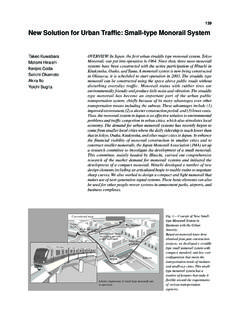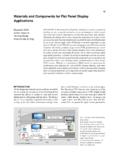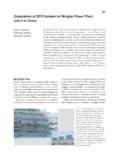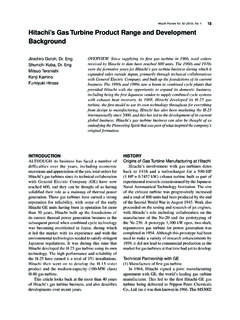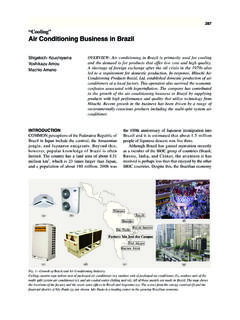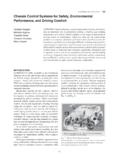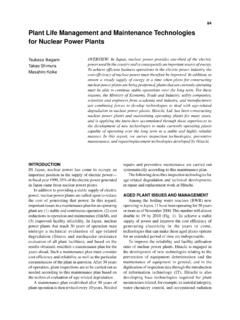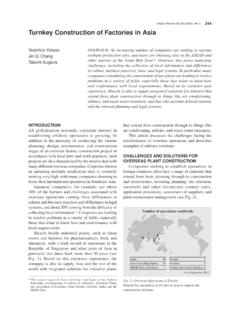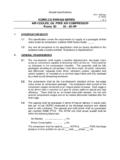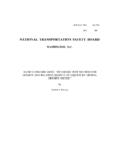Transcription of One Drop Filling for Liquid Crystal Display Panel …
1 One Drop Filling for Liquid Crystal Display Panel produced from Larger-sized Mother Glass 144 One Drop Filling for Liquid Crystal Display Panel Producedfrom Larger-sized Mother GlassOVERVIEW: A cell-assembly line for Liquid - Crystal panels is a process forfitting together two glass substrates ( a TFT substrate mounting the drivecircuit for the Liquid - Crystal Display and a CF substrate for displaying colors)in an arrangement that Liquid - Crystal material is filled between the Liquid - Crystal vacuum Filling system accomplishes dropping method namely, a method in which Liquid - Crystal material is dropped directly ontoone of the substrates, which is then aligned with the other substrate (withsealant dispensed on it) and bonded to it under vacuum. In this way, theweak point associated with the LCD injection method (that is, Liquid -crystalinjection requires a long time) is eliminated and lead time of cell process issignificantly shortened, thereby opening up the way to expand the size ofliquid- Crystal panels .
2 Hitachi Plant Technologies, Ltd. is providingmanufacturing equipment with productivity that fits the needs of particulargenerations in accordance with the expanding market for Liquid -crystalpanels which is succeeding lap-top PCs, monitors, and HiraiIsao AbeMasaru MitsumotoShigeru IshidaINTRODUCTIONAS a medium for conveying a broad range ofinformation by mobile phones, PDAs (personal digitalassistants), games, lap-top computers, Liquid -crystalmonitors, and Liquid - Crystal TVs (televisions), Liquid - Crystal panels whose practical application startedin calculators and watches are creating newapplications while their market continues to particular, Liquid - Crystal TVs are continuing toreplace CRT (cathode-ray-tube) TVs because they notonly take advantage of the basic characteristics ofliquid crystals themselves ( compactness, lightnessin weight, and low power consumption) but also realizehigher resolution, wider viewing angle and high-speedresponse (which has been a weak point of conventionalliquid crystals).
3 Furthermore, the popularization ofliquid- Crystal TVs is being spurred on by the facts thatthe provision of high-quality content is becomingwidespread, various countries ( Holland andSweden) have completely switched over to digitalterrestrial broadcasting, and the changeover period formany other countries is drawing practical application of the LC (liquidcrystal) dropping method called ODF (one-dropfilling)(1), which aligns, assembles, and pastes togetherunder vacuum a CF (color filter) substrate and a TFT(thin film transistor) substrate (in such a condition thatliquid- Crystal material is then dropped onto one ofFig. 1 Sealant-dispensing Unit andVacuum-assembling UnitComposing Liquid - Crystal Vacuum- Filling Plant Technologies, Ltd. isproviding a sealant-dispensing unitand a vacuum-assembling unitcomposing a vacuum- Filling systemfor handling growth in size of Liquid - Crystal unitVacuum-assembling unitHitachi Review Vol.)
4 57 (2008), No. 3 145a big screen can be enjoyed without feeling anysensation of oppression even if the screen size is scaledup compared to a conventional TV size. Moreover, wide sizes of screens with a 16:9 horizontal-to-vertical ratio have become popular, and the hot-sellingitems are continuing to shift to 40-inch and even biggersizes. Accompanying this shift is the scaling up of themother glass to the seventh-generation size (1,870 2,200 mm), yielding eight 40-inch panels , and on tothe eighth-generation size (2,200 2,500 mm),yielding eight 47-inch the mother-glass size has been scaled up, thefabrication equipment that constitutes the cell-assembly process has also increased in size. With thisincrease in scale of the fabrication equipment,equipment structural design accounting for deliveryconstraints and on-site assembly, basic mechanicaldesign considering tact time and accuracy, andmaintaining cleanliness and stability become the UNITD ispensing-head Moving Type with GoodSpace EfficiencyThe sealant-dispensing unit applies a sealant to oneof a pair of glass substrates, where the sealant s task isto join the upper and lower glass substrates aroundthe periphery of a Liquid - Crystal Panel in the state thata Liquid - Crystal material fills the interior of the regards the dropping method, in contrast to theconventional injection method, dispersion isperformed so as to form a closed-loop pattern withoutthe substrates), Hitachi Plant Technologies, Ltd.
5 Iseliminating the main weak point of the LC injectionmethod (which has been a major barrier to expandingthe size of Liquid - Crystal panels ) and paving the waytowards scaling up Liquid - Crystal popularization rate of large-scale Liquid -crystalTVs is, however, quickening; consequently, it is saidthat further reduction in set pricing is necessary, andeach Panel manufacturer is continuing technicaldevelopment and capital investment aimed at the rest of this report, as part of the Liquid -crystalvacuum Filling system for handling mother glass(which is getting bigger and bigger), a sealant-dispensing unit and a vacuum-assembling unit, whichconstitute the cell assembly process, are described (seeFigs. 1 and 2).NEEDS REGARDING LARGE LCD PANELSThe mother glass for producing Liquid -crystalpanels comes in predetermined sizes in such a waythat six or eight panels can be manufacturedsimultaneously for the sake of manufacturingefficiency.
6 The sixth-generation of glass substrates hasa dimension of 1,800 1,500 mm, from which eight32-inch panels can be taken off. (Note that the glassdimensions stated here are given as representativeexamples.) At present 30- to 32-inch Liquid - Crystal TVsare the most popular. Compared to conventional CRTTVs, Liquid - Crystal TVs take up less space thanks totheir thin, flat screens. Moreover, since the optimumviewing distance is three times the height of the screen,Fig. 2 Line Configuration of Cell-assembly cell assembly process consists of apparatuses for sealant dispensing, dot dispensing, Liquid - Crystal drop,vacuum assembling, UV light hardening, and position inspection as well as transfer units such as robots andpositioning and transfer dispensingTFT substrateCF substrateSealant dispensingLiquid- Crystal dropTFT: thin film transistor CF: color filter UV: ultravioletVacuum assemblingUV light hardeningPositioning inspectionOne Drop Filling for Liquid Crystal Display Panel produced from Larger-sized Mother Glass 146an , dispensing of the sealant isperformed while the dispensing head is fixed and thetable is moved.
7 However, with this method, space inwhich the mother glass moves is necessary, andequipment cannot be configured to fit into conveyor-width limitations. As a result, in response to the trendtowards large-scale mother glass, systems that have amovable head and a fixed table are being switchedover to (see Fig. 3).The dispensing head is set on the gantry frame andmoves in the X direction within the frame. And movingthe gantry frame in the Y direction enables a givenpattern to be drawn. Moreover, to shorten thedispensing tact time, multiple heads are set up, andtheir movement in the X direction is controlledsimultaneously. The movement of the dispensingenables the multiple heads to be positioned along thesame axis of displacement by utilizing a linear motorin place of the conventional ball screws and a servomotor.
8 By executing movement in the Y direction ofthe gantry frame using linear motor and by setting upthe gantry frames as a pair, it is possible to furthershorten the tact time and reduce the surface area takenup by the Moving-frame StructureAs for a conventional moving-table-type dispenser,the head is moved before dispensing the sealant, andduring the dispensing process, the head is a result of this setup, contaminant particles areprevented from sticking on the dispensing substrateglass. On the contrary, in the case of the moving-head-type dispenser, the dispensing head and the gantryframe move above the substrate during the dispensingprocess. Consequently, it has been necessary to takeever more notice of the sticking of those circumstances, by adopting a less-particle cable structure in conjunction with optimizingpartial exhaust and improving the configuration of boththe dispensing head and gantry frame, it is possible toeliminate the particles on the substrate and, in doingso, attain a thoroughly clean dispensing process andimprove the ratio of good quality Liquid - Crystal High-precision DispensingThe sealant dispenser measures the distancebetween the dispensing nozzle and the glass substrateat the vicinity dispensing point.
9 This value is thencontrolled in real-time so that it corresponds at all timeswith a pre-set the corners of a Panel , the sealant-dispensingrate varies rapidly. Accordingly, in this region, controlof dispensing pressure (which is responsible forextruding the sealant) is performed in coordinationwith the above distance-value the time for dispensing sealant increaseswith the scaling-up of Panel size, it is necessary toincrease the dispensing speed so that sealant can bedispensed in a shorter time even in the case of largerpanels. Accordingly, distance control and controlperformance of dispensing pressure are furtherimproved, thereby creating high-speed and high-accuracy dispensing of sealant (see Fig. 4).VACUUM ASSEMBLY UNIT (2),(3)Stable Holding of Glass SubstrateThe vacuum assembly equipment aligns undervacuum the substrate with sealant applied and thesubstrate with Liquid - Crystal material dropped onto itby means of an alignment mark set at each corner ofeach substrate, and after that it pressurizes usingatmospheric pressure and bonds the substrates accomplish bonding of the glass substrates undervacuum, it is necessary to hold the two glass substratesin a particular manner that the upper glass substratedoes not touch the lower substrate under vacuum, andafter the substrates are positioned, the upper one isassembled and bonded to the lower this holding and positioning undervacuum makes the dropping method possible, and theFig.
10 3 Basic Structure of Head-moving-type Sealant-dispensing unit is composed of two pairs of gantry frames that travelalong the Y direction and multiple dispensing heads (whichtravel along the X direction in the gantry frame).Substrate tableRecognition cameraDispensing headX directionY directionGantry framesHitachi Review Vol. 57 (2008), No. 3 147and a lower substrate table. It positions the glasssubstrates under vacuum and then bonds them ensure that no influence is exerted by deformationof the vacuum chamber, the lower substrate table issupported by free joints and legs fixed to a lower base,and it can move in the horizontal direction. Moreover,its movement can be controlled along three horizontalaxes (X,Y, and ) by three drive shafts fixed to theexterior of the chamber. By arranging the drive systemon the exterior of the chamber in this way, cleanlinessinside the chamber is maintained.
